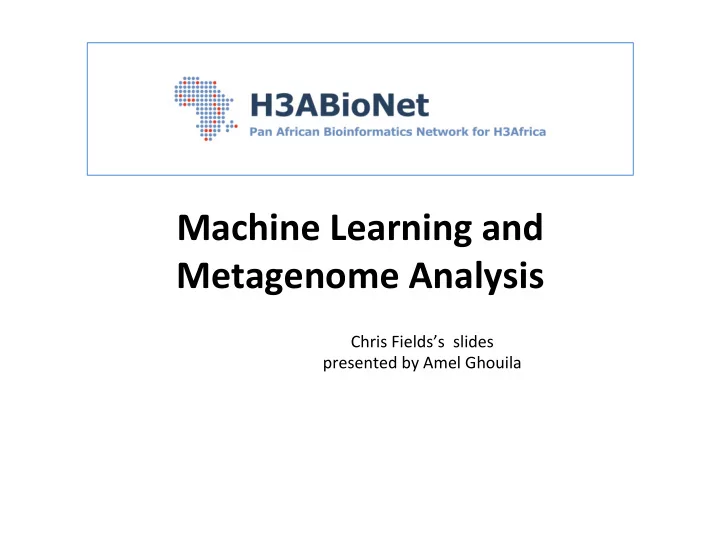

Machine Learning and Metagenome Analysis Chris Fields’s slides presented by Amel Ghouila
Overview of Overview of analysis analysis workflow workflow ASSEMBLY ( DE NOVO ) FASTQC RECONSTRUCTION OF QUALITY CONTROL F ASTQ A GENOME OF READS FILES 1 TRIMMING 2 MAPPING FILTERING BAD OF READS TO A QUALITY READS REFERENCE GENOME FASTA FILE GFF FILE SAM FILES ANNOTATION 3 VISUALIZATION READ DEPTH 4 BAM FILES STRUTURAL SNP S VARIATIONS I N D ELS GENE / CHR CNV VCF VARIANT CALLING 5 FILES 2
Overview of metagenome analysis • What is metagenomics? – The study of the collective genomic material from environmental samples, for example • Environment : soil, water • Medical : fecal, skin, kidney stone • Industrial : bioreactors, fermenters, enrichments • Pretty much anything
Overview of metagenome analysis • Why? – Characterize a sample that may be of “biological interest”, but… – The vast majority of microorganisms cannot be cultured – Methods used to culture from environmental samples miss these • Solution : isolate DNA from samples, sequence it, then break down what is there. – Yes, it’s as difficult as it sounds
Overview of metagenome analysis • Solution : isolate DNA from samples, sequence it, then break down what is there. – Taxonomic – what is present? – Functional – what can be done metabolically (e.g. metabolic potential)? • Note, this cannot be done with 16s directly
Overview of metagenome analysis • Note: depending on the question, may be complementary (and similarly difficult) data – Metatranscriptome – what is being expressed in environmental samples (RNA) – Metabolome – metabolites produced – Proteome – proteins present in sample
Overview of metagenome analysis • Two general approaches – Targeted sequencing (e.g. 16s variable regions) – Shotgun (whole) metagenome sequencing
Targeted analysis Morgan XC, Huttenhower C (2012) Chapter 12: Human Microbiome Analysis. PLOS Computational Biology 8(12): e1002808. OTU: Operational Taxonomic Unit (cluster of similar sequence variants) used to categorize bacteria
Targeted analysis Morgan XC, Huttenhower C (2012) Chapter 12: Human Microbiome Analysis. PLOS Computational Biology 8(12): e1002808. k-NN Hierarchical clustering Bayesian clustering Greedy heuristic clustering Tools Mothur USEARCH/UCLUST/UPARSE CD-HIT
Targeted analysis Morgan XC, Huttenhower C (2012) Chapter 12: Human Microbiome Analysis. PLOS Computational Biology 8(12): e1002808. Linear model Random forest Tools RDP Classifier 16s Classifier PhyloSift PhyloPithia
Shotgun metagenome analysis • Full sequencing of the genomic content of an environmental sample. • Two general methods in analysis: – Assembly-based: assemble the sequences, then classify the contigs from the assembly into ‘bins’, followed by gene prediction, annotation, and some form of quantifying and normalizing data for comparison across samples – Read-based: analyse the unassembled reads directly against a database of interest, then assign taxonomy and function when possible
Shotgun metagenome analysis Quince, C et al. Shotgun metagenomics, from sampling to analysis, (2017) Nature Biotechnology (35):833–844
Metagenome analysis - Binning ML Model Linear regression Int. Markov Model Tools PCA CONCOCT SVD MetaBAT Lots of Clustering! k-means MaxBin k-medioids Gaussian mixture model Greedy heuristic Bayesian clustering Spectral clustering Sedlar, K et al, Bioinformatics strategies for taxonomy independent binning and visualization of sequences in shotgun metagenomics. Computational and Structural Biotechnology Journal 15:48-55. 2017
Shotgun metagenome analysis http://armbrustlab.ocean.washington.edu/seastar
Shotgun metagenome analysis • Let’s say you have a metagenome assembly • Now you have to annotate it to get functional information Tools ML Model HMM MetaProdigal Neural network MetaGeneMark Int. Markov models FragGeneScan Sharpton, T. An introduction to the analysis of shotgun metagenomic data. Front. Plant Sci., 16 June 2014
What next? • At the end, you normally end up with quantitative information related to: – Taxonomic counts – Feature counts (genes, protein families) • These can go into standard downstream packages for analysis (phyloseq, MEGAN, etc) – Normally involves performing some form of ordination (PCoA, MDS, etc)
ML used for classification
Figure 5 : Gut MLGs classify colorectal carcinoma and adenoma samples from healthy controls.
Nice literature overview https://arxiv.org/pdf/1510.06621.pdf
ML – Overview
ML – OTU Clustering
ML - Binning
ML – Taxonomic Classification
ML – Gene Prediction
Recommend
More recommend